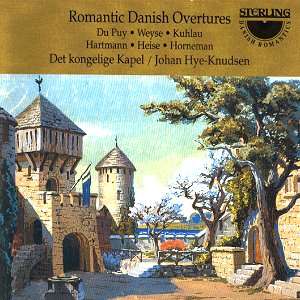
EDOUARD DU PUY (1773-1822) Youth
and Folly overture 1806 7.43
C E F WEYSE (1774-1842) The
Sleeping-Draught overture 1809 4.43
FRIEDRICH KUHLAU (1786-1832)
William Shakespeare overture 1826 9.57
J P E HARTMANN (1805-1900) Little
Kirsten overture 1846 8.35
PETER HEISE (1830-1879) King and
Marshal overture c. 1878 9.49
C F E HORNEMAN (1840-1906)
Aladdin fairy tale overture 1863
Until this disc I had never heard of Du Puy. He was educated in Switzerland
and Paris and having settled in Copenhagen he made quite a name for himself
among the ladies of Copenhagen and among concert-goers. The overture skims
through waters much frequented by Mozart and Weber. There is a lightness
of spirit straight out of Schubert's first two symphonies and a splash of
Beethovenian angst in the introduction and closing bars. By the side of the
Du Puy, the Weyse, redolent of Mozart and early Beethoven, seems less inspired
although certainly an attraction.
The Kuhlau work is (comparatively) a much more modern work than the Weyse
and Du Puy. His original tonalities are both dark and lucid with the Beethoven
of the beetling brows (Egmont and Coriolan) never far from
home. The fanfares and the fast galloping finale may well have been known
to Tchaikovsky before he wrote the Fourth Symphony.
Hartmann's Little Kirsten is a positive charmer with the work announcing
itself with the solo harp (later to return) and soon asserting a Mozartian
stealth, adding some rustic dances, Mendelssohnian squawls and a wistful
tunefulness. A modern dramatic sensibility is apparent in the closing pages.
Heise's overture is dramatic, of darker moment and gloomy with the voices
of Mendelssohn (Symphonies 3 and 4) and Tchaikovsky apparent either in echo
or anticipation. Horneman's Aladdin (is the same play for which Nielsen
provided incidental music (lovingly recorded by Chandos in Rozhdestvensky's
account) and by Busoni in the finale of his piano concerto. Horneman produces
a fine rumpus with darkling clouds skimming the moonlit desert skyline.
Mendelssohn and Beethoven (Symphony No. 7) remain presences in this agreeable
music which deserves a place alongside The Fair Melusine,
Coriolan, Midsummer Night's Dream and Egmont. The central
and extremely attractive 'harper's romance' seems to step from a much later
era. The closing zestful revels provide links with Berlioz's Byronic
Corsair.
The performances are very much in touch with the predominantly fleet (and
often Mozartian) elegance of this music and the beefy recording has an apposite
weight.
Recommended.
Reviewer
Rob Barnett


